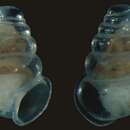en
names in breadcrumbs


Zospeum ist eine Gattung winziger, ausschließlich in Höhlen lebender Schnecken, die zu den Zwerghornschnecken (Carychiidae) innerhalb der Lungenschnecken (Pulmonata) gezählt werden. Aufgrund ihrer geringen Größe, werden sie auch (nicht-systematisch) als Mikrogastropoden bezeichnet.
Die rechtsgewundenen Gehäuse sind sehr klein (1 bis 2,5 Millimeter hoch und 0,8 bis 1,5 mm breit) und dünn. Lebendige Tiere besitzen ein transparentes Gehäuse, das nach Tod eine milchig-weiße Farbe erhält. Die Gehäuseoberfläche ist glatt oder mit Spiralstreifen versehen. Die Mündung ist lippig verdickt, mit einem Parietalzahn und zwei Spindellamellen. Die obere Spindellamelle endet auf der Mündungswand.
Die Tiere sind zwar Zwitter, die Befruchtung ist jedoch einseitig, d. h. ein Partner fungiert als Weibchen, der andere als Männchen. Das als Weibchen fungierende Tier bildet den Penis zurück.
Die Vertreter der Gattung Zospeum sind palaearktisch verbreitet; kürzlich gemachte Funde in Höhlen von Südchina[1] und Südkorea[2] erweitern das Areal beträchtlich weiter nach Osten. Vor dieser Entdeckung war das Areal auf Europa beschränkt. Allerdings muss die Zugehörigkeit der asiatischen Funde zu Zospeum noch abgesichert werden.
Die Zospeum-Arten sind ausschließlich Bewohner von Höhlen und unterirdischen Karstspalten. Man findet sie von Meereshöhe bis in 1850 m. Die Tiere leben an den ständig feuchten Höhlenwänden, am Höhlenboden oder auch auf verrottendem Holz. Sie bewegen sich dabei nur etwa 1 bis 15 cm in der Woche, im Durchschnitt etwa 7 mm pro Tag, und dies bei einer Temperatur von zumeist unter 10 °C und einer Luftfeuchtigkeit von 97 bis 100 %.
Die Gattung wird übereinstimmend zu den Zwerghornschnecken (Carychiidae) gerechnet, die jedoch teils als Familie der Überfamilie Ellobioidea, teils als Unterfamilie der Familie der Küstenschnecken (Ellobiidae) behandelt wird. Die Artenzahl ist derzeit noch unsicher, da es bisher keine moderne, umfassende Revision der Gruppe gibt. Animalbase führt 17 Arten auf,[3] die Fauna Europaea 21 Arten,[4] wobei die Animalbase eine Art auflistet, die bei der Fauna Europaea fehlt. Zudem werden noch mehrere Unterarten unterschieden. Weitere Arten werden in der Mollusc Data Base aufgeführt:[5]
Die Arten sind z. T. sehr schlecht bekannt, die meisten sind nur gehäusemorphologisch definiert. Es ist durchaus möglich, dass sich einige von ihnen als Synonyme erweisen und sich die Anzahl der Arten dadurch reduzieren könnte. Auf der anderen Seite erbrachte die Integration von molekularen Daten die Erkenntnis, dass insbesondere variable und weitverbreitete Zospeum Morphoarten mehrere kryptische Evolutionslinien beinhalten.[12] Viele der Arten sind nur aus einer kleinen geografischen Region oder gar als Höhlenendemiten bekannt.[13]
Zospeum ist eine Gattung winziger, ausschließlich in Höhlen lebender Schnecken, die zu den Zwerghornschnecken (Carychiidae) innerhalb der Lungenschnecken (Pulmonata) gezählt werden. Aufgrund ihrer geringen Größe, werden sie auch (nicht-systematisch) als Mikrogastropoden bezeichnet.
Zospeum is a genus of air-breathing land snails, terrestrial pulmonate gastropod mollusks in the family Ellobiidae, the salt marsh snails.
Species within the genus Zospeum include:
Zospeum is a genus of air-breathing land snails, terrestrial pulmonate gastropod mollusks in the family Ellobiidae, the salt marsh snails.
Zospeum es un género de caracoles terrestres que respiran aire, moluscos gasterópodos pulmonados de la familia Ellobiidae. Son de pequeño tamaño y su hábitat es exclusivamente hipogeo. El género está presente en zonas kársticas del norte de la península ibérica, los Alpes y la región balcánica
Las especies dentro del género Zospeum incluyen:
Zospeum es un género de caracoles terrestres que respiran aire, moluscos gasterópodos pulmonados de la familia Ellobiidae. Son de pequeño tamaño y su hábitat es exclusivamente hipogeo. El género está presente en zonas kársticas del norte de la península ibérica, los Alpes y la región balcánica
Zospeum airea arnasten duten lur-lehorreko barraskilo genero bat da. Ellobiidae familiako gastropodo pulmonatu bat da. Batez ere kobazuloetan bizi dira.
Zospeumen oskoloak txikiak dira, 1-2,5 milimetro altueran eta 0,8-1,5 milimetro zabaleran, eta finak dira. Zospeum bizidunek oskol gardena dute, eta hil ondoren kolore zuria hartzen dute. Gainazala fina eta leuna da, lerrotxoekin espiralak egiten. Animalia hermafroditak dira, inseminazioa albo batetik egiten dute, batek eme papera hartzen duelarik eta besteak arrarena.
Zospeum espezieak kobazulo karstikoetan baino ez dira bizi. Itsas mailatik 1.850 metro arteko altueraraino aurki daitezke. Kobazuloek hezetasun konstantea behar dute. Mugimendu geldoa dute, aste oso batean zentrimetro batetik hamabostera egiten dituztelarik. 10 °C baino hotzago egiten duten kobazuloetan bizi ohi dira, %97ko hezetasunetik gora.
Zospeum airea arnasten duten lur-lehorreko barraskilo genero bat da. Ellobiidae familiako gastropodo pulmonatu bat da. Batez ere kobazuloetan bizi dira.
Zospeum est un genre d'escargots terrestres à respiration aérienne de type mollusque pulmoné (Pulmonata). Ce gastéropode appartient à la famille des Ellobiidae. De petites tailles, ils vivent essentiellement dans des grottes.
La coquille des Zospeum est très petite (1 à 2,5 mm de hauteur et 0,8 à 1,5 mm de large) et mince. Les Zospeum vivants ont une coquille transparente qui reçoit une couleur blanc laiteux après la mort. La surface de la coquille est fine et lisse avec des rayures en spirale. Ces animaux sont de véritables hermaphrodites, l'insémination est effectuée sur un côté avec un partenaire, l'un agissant en tant que femelle, l'autre comme mâle.
Les espèces de Zospeum sont exclusivement des habitants de grottes et de colonnes karstiques. Ils se trouvent à partir du niveau de la mer à 1850 m. Ces escargots vivent sur les parois des grottes constamment humides, sur le sol de la grotte ou sur du bois pourri. Ils se déplacent, avec seulement environ 1 à 15 cm par semaine, en moyenne, soit environ 7 mm par jour, dans une température habituellement inférieure à 10 °C et à une humidité de 97 % à 100 %.
Le nombre d'espèces de Zospeum est encore incertain, car il n'existe pas encore de révision moderne et complète pour ce genre.
Zospeum est un genre d'escargots terrestres à respiration aérienne de type mollusque pulmoné (Pulmonata). Ce gastéropode appartient à la famille des Ellobiidae. De petites tailles, ils vivent essentiellement dans des grottes.
Zospeum é um género de gastrópode da família Carychiidae.
Este género contém as seguintes espécies: